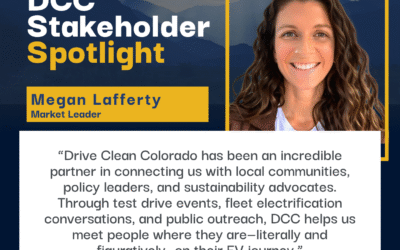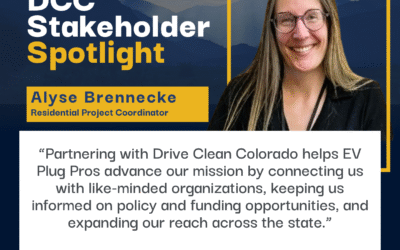Four Corners Office for Resource Efficiency (4CORE) is a nonprofit organization that promotes resource conservation, energy efficiency and renewable energy by educating the community. They provide programs and projects designed to provide energy and cost savings, specifically to lower income residents, and encourage the adoption of clean transportation. As one of our peer partners, we are excited to highlight 4CORE’s work with sustainability education and implementation. Laurie Dickson, Executive Director of 4CORE, chatted with us about the organization’s mission, the challenges they have faced and how they have been combating them. Keep reading to learn more 4CORE’s great work.
Organization: Four Corners Office for Resource Efficiency (4CORE)
Location: Durango, CO
*Note: The following answers are summarized from an interview with Laurie Dickson from 4CORE.
How does your work at 4CORE align with your organization’s mission?
Right now, what we are really focused on are programs and projects that really reduce our impact on the environment, especially the climate crisis, be reducing harmful greenhouse gas (GHG) emissions. Obviously, transportation is one of those, but our organization does a lot of energy efficiency projects for residents and commercial buildings to help them reduce their impact as well. To address the air quality issues, we must ask ourselves “how do we reduce fossil fuels and provide pathways to renewable energy?”. We have done solar for low-income housing and some water conservation projects and all of it is directed towards resource conservation. Everything is under this umbrella of reducing our impact on the environment and reducing harmful GHG emissions and in addition to being the goal of our organization, it is a passion of mine as well.

As a ReCharge coach, what is the most important piece of advice you have for city sustainability managers in your region?
This is a conversation I like to have all the time. The needs of rural Colorado are different from those in the metro area. The promotion and adoption of electric vehicles (EVs) is important, but the infrastructure is what is most critical. A good example is a friend of mine who was a Bolt driver. He loved his Bolt and drove it all the time, but he recently traded it in for a Tesla and one of the reasons why is range. We travel farther, I think, in rural areas of Colorado and so the infrastructure piece and range of our vehicles are the two limiting factors. I get emails continually from people asking when DC fast chargers are going to be available in certain areas and a big part of why that it so difficult is because of utilities. The utilities always have very different rate structures, which can be very limiting for the demand charge for DC fast charge stations. If the demand charge rate is too high, putting in a fast charger can be cost prohibitive because the use would not very high and therefore would not outweigh the cost of the station. Everything is so multifaceted in terms of sustainability managers, but my advice would be to have a good partnership with utilities so that those demand charges really promote, develop the EV infrastructure and learn how to deal with and combat range anxiety. Another barrier for electrification out here is that all wheel drive and high clearance are coveted, making two-wheel drive low clearance EVs not as appealing.
Do you have any advice for consumers looking for EVs?
I am the enthusiastic voice of switching to an electric vehicle more than the advice-giver. I focus more on the education and awareness EVs, letting people know that switching doesn’t have to be this crazy difficult process. You don’t have to install a whole new system in your garage to have an EV, you can plug it into a 110 socket and charge just fine. Getting an EV is one of those things where once people do it, they realize how easy it is. Think of it like having a cellphone; you hardly ever get down to 5% charge before you are plugging in again. In addition, a lot of workplaces now have chargers that people can use while at work instead of just having to charge at home. The average person only drives about 40 miles a day, so if your car has a range of 200-250 miles, you’ve got 7 days there before you have to charge, theoretically. I remember a few years back, someone said “well, when I can go 1,000 miles without having to charge, then I’ll think about getting an EV”, but when you think about it, when have you ever driven 1,000 miles? From Colorado, 1,000 miles gets you almost to California. If you take a trip there, you are going to stop for food or bathroom breaks or even just to stretch your legs. No one goes 1,000 miles straight with no breaks, so having an EV with that kind of range is unrealistic. There aren’t even gas vehicles available that could take you 1,000 miles without having to fill up, so that kind of thinking doesn’t make sense. That is where the education comes in, teaching people that driving an EV really isn’t much different than driving a gas vehicle.
What challenges do you face for clean transportation in your region? In addition, how has COVID affected these challenges?
There are certainly challenges with EV adoption in our region, and some of them are different than those faced by more urban areas. The most pressing ones we face are trying to get dealerships involved with EV sales, model availability, and education at the dealerships. People are starting to see the value of having EV charging at their workplace or business, but the transition is slow since the demand for chargers is lower out here. I am a big advocate for in person engagement and historically we have had some incredible summits and events, so with COVID in the way it has been difficult to replicate that same level of engagement. The Ride & Drives have probably been affected the most, we can do them virtually but there is nothing quite like getting behind the wheel of an EV. I think in order to have more electric vehicles in our community, we must have more availability in dealerships.

See more DMCC Member Spotlights or learn more about joining DMCC today!






